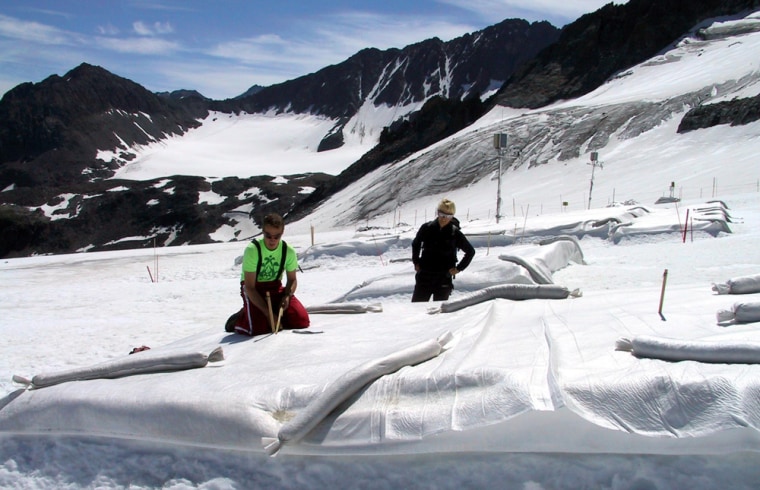Add glaciers to the growing list of things endangered or threatened in nature.
Most glaciers will disappear from the Alps by 2050, scientists told a conference on climate change Monday, basing their bleak outlook on evidence of slow but steady melting of the region’s continental ice sheets.
In western Austria's Alpine province of Tyrol, glaciers have been shrinking by about 3 percent a year, meaning their mass decreases annually by roughly 3 feet, said Roland Psenner, of the University of Innsbruck's Institute for Ecology.
And 2050 is a conservative estimate, he said: If they keep melting at that rate, most glaciers could vanish by 2037.
"The average density of glaciers in the Alps is 30 meters (100 feet), so it seems rather certain that there won't be any more glaciers except for a few high ones that lay above 4,000 meters (13,000 feet)," Psenner said.
"The future looks rather liquid," he said.
Experts at a regional conference on the Alps, held annually in the mountain resort of Alpbach, stopped short of blaming global warming. But they called for a review of preventive measures to protect people living in valleys who could face a higher risk of dangerous flooding.
Runoff from melting glaciers caused severe flooding that devastated parts of Switzerland in the summer of 2005.
Swiss agency sees eroding mass
Glacial melting is a global problem, according to the Zurich-based World Glacier Monitoring Service, which keeps tabs on 30 ice sheets in nine mountain ranges worldwide and says their average mass is steadily eroding.
Glaciers are the planet's largest source of fresh water after polar ice. In Europe, they're also hugely popular with skiers and snowboarders seeking year-round thrills and help anchor a multimillion-dollar tourist industry.
In 2005, glacier thickness decreased by an average of 23.5 inches, and in 2004 by an average of 27.5 inches, the Swiss agency said, citing preliminary measurements.
Since 1980, it said, Europe's glaciers have lost about 31.5 feet of ice. About 7 feet melted away in a single summer — 2003 — when a heat wave zapped much of Europe, said Michael Zemp, a glacier expert at the University of Zurich.
"What's important for a glacier is winter snow accumulation and a cold summer with not a lot of melting," Zemp said Monday in a telephone interview. "A bad year for a glacier is a dry winter and a hot summer, and these are the conditions we've been seeing."
"Glaciers have been in a general retreat worldwide since the end of the last Ice Age," he said.
'Accelerated glacial melting'
Forecasting their demise is problematic "because we don't know what scenarios there will be, and there are a range of scenarios. This isn't a weather forecast. But we are seeing an accelerated glacial melting."
In the 13 years spanning 1991-2004, twice as much glacial ice melted away in Europe than in the 30 preceding years from 1961-1990, climatologists say.
Underscoring a glacier's vulnerability, for every 1 degree Celsius rise in temperature, it needs a corresponding 25 percent increase in precipitation just to maintain its mass.
To be sure, a few glaciers have more staying power: Switzerland's Great Aletsch Glacier is still more than a half-mile thick and seems destined to survive well into the 22nd century.
But data collected by aircraft and satellites since 2002 has shown that many of Earth's estimated 160,000 glaciers from the Rocky Mountains to the Himalayas have been shrinking.
Scientists say the phenomenon has been occurring for more than a century, suggesting that manmade emissions of carbon dioxide are combining with purely natural factors, such as a shift in jet streams pumping warmer air into traditionally cooler northern climes.
Commuting tips
Even in Austria, a relatively sparsely populated country of 8.2 million people, passenger cars alone chug 11.4 million tons of carbon dioxide into the atmosphere each year, the nation's leading automobile club said Monday.
It urged commuters to consider walking or cycling to work, and called on motorists to ease back, saying a recent study showed that every 10th drive covers half a mile — a distance easily traveled on foot or with a bike.
Europeans, meanwhile, have fretted and sweated their way through an unusually balmy winter that has shattered temperature records and forced World Cup ski organizers to cancel competitions for lack of snow.
"Winter has been in a holding pattern," said Gerhard Baumgartner, a meteorologist with Austria's national weather service.
